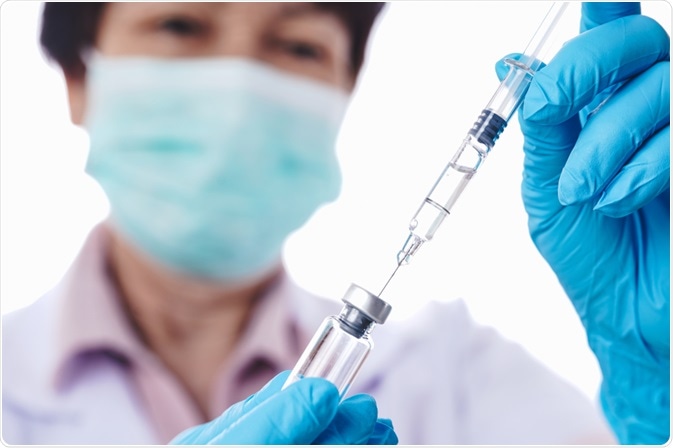How Can Affinity Chromatography be Used to Manufacture Vaccines?
Despite the numerous advantages associated with worldwide vaccination, there remains a significant disparity in the availability of vaccines throughout the world.

Image Credit: KiattisakCh/Shutterstock.com
This limited availability is often due to the complex processes and high cost associated with producing a sustainable amount of vaccines.
Recent research on the advancing technology of affinity chromatography shows promising results on how this analytical tool can promote a commercial and large-scale production of vaccines.
Producing vaccines
Several different technologies are incorporated into the formulation, stabilization, and production of vaccines. The selected production method used to manufacture a certain vaccine can determine the quality and cost of producing these products.
For example, whereas the preparation for the oral polio vaccine can be achieved at a high capacity that ultimately allows for hundreds of millions of vaccine doses to be produced at a low cost, more complex vaccines, such as those required for the immunization of meningococcus, are often associated with a much lower dose yield, thereby limiting the ability to produce such vaccines on a larger scale.
Regardless of which method is selected, the production of vaccines requires the utmost level of quality control at each stage of the process. To this end, several assays are used to confirm the pH, osmolality, potency, concentration, component identify and stability of any antigen, excipient, and adjuvant used throughout the vaccine production process.
Constraints in vaccine production
During the traditional purification of complex systems like single-cellular and multicellular eukaryotes, as well as transgenic organisms, common methods incorporated into this process include cell disruption, precipitation, clarification, gradient ultracentrifugation, size exclusion chromatography and several other chromatographic techniques, such as ion exchange and hydrophobic interaction chromatography.
Some of the limitations associated with these techniques include long processing time, low production yields and an overall lack of process standardization, each of which can increase the resource demand on institutions that are responsible for producing vaccines.
Advantages of affinity chromatography
To address the constraints associated with traditional vaccine preparation methods, affinity-based chromatography techniques appear promising.
The methodology behind affinity chromatography (AC) is based on interactions between the target molecule and the immobilized ligand that allow for the separation of molecules of interest from the crude process stream.
When the appropriate ligand is used, AC is capable of achieving a high level of purity in a single step. The need to incorporate additional modification methods downstream can be eliminated when a single AC capture step is accompanied by a prior clarification process and a subsequent polishing step.
Additionally, AC has demonstrated its suitability for purifying both free and conjugated carrier proteins, such as diptheria toxoid, Neisseria mengitidis, Haemophilus influenzae protein D and tetanus toxoid.
Confirming AC potential
Several different AC techniques have already been investigated at the laboratory scale for their ability to assist in vaccine preparation. For example, immunoaffinity chromatography (IAC), which is a column-based technique that separates a heterogenous solution through specific antigen-antibody interactions has already been applied for the vaccine purification of several viruses, toxins, and proteins.
Some of the viruses that have been separated by IAC for this purpose include canine parvovirus (C PV), Aleutian mink disease virus, Heptatis A Virus, polivirus type 1, AAV-2 capsids, AAV serotype1, 2, 3 and 5, measles and infective mumps virus particles that originate from non-infectious particles.
Similarly, the tetanus toxin, chimeric diptheria toxin, Clostridium perfringens enterotoxin and Clostridium perfringens ß-toxin have also undergone successful separation by IAC.
In addition to IAC, the other three major types of AC that have already been successfully applied to laboratory-scale vaccine purification processes include lectin affinity chromatography, immobilized metal affinity chromatography (IMAC) and heparin and heparin sulfate pseudo-affinity chromatography.
Whereas lectin affinity chromatography involves the binding of ligands to specific carbohydrates through the use of carbohydrate recognition domains (CRD), IMAC is an AC technique that allows for ligands comprised of certain immobilized metal ions to interact with donor groups present on the surface of the target molecule.
Conclusion
The significant simplification that can be achieved by incorporating AC into the vaccine production process has demonstrated the ability of this technique to decrease time-to-market, which can be a crucial factor when devastating viral diseases arise in remote areas, as well as improve the cost-efficiency of vaccine production.
Furthermore, AC can assist in increasing the productivity rates of vaccine preparation to ultimately allow these life-saving treatments to reach those in need around the world.
Sources
- Zhao, M., Vandersluis, M., Stout, J., Haupts, U., Sanders, M., & Jacquemart, R. (2019). Affinity chromatography for vaccines manufacturing: Finally ready for prime time? Vaccine 37(36); 5491-5503. DOI: 10/.1016/j.vaccine.2018.02.090.
- Smith, J., DPhil, M., & Almond, J. W. (2011). Vaccine production, distribution, access, and uptake. The Lancet 378(9789); 428-438. DOI: 10.1016/S0140-6736(11)60478-9.
Further Reading
- All Chromatography Content
- Chromatography Overview
- Gas Chromatography-Mass Spectrometry (GC-MS) Applications
- High Performance Liquid Chromatography (HPLC)
- Liquid Chromatography-Mass Spectrometry (LC-MS) Applications
Last Updated: Feb 7, 2020

Written by
Benedette Cuffari
After completing her Bachelor of Science in Toxicology with two minors in Spanish and Chemistry in 2016, Benedette continued her studies to complete her Master of Science in Toxicology in May of 2018.During graduate school, Benedette investigated the dermatotoxicity of mechlorethamine and bendamustine, which are two nitrogen mustard alkylating agents that are currently used in anticancer therapy.
Source: Read Full Article


